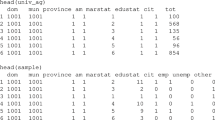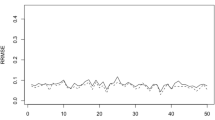Abstract
Estimation of small area totals makes use of auxiliary variables to borrow strength from related areas through a model. Precision of final small area estimates depends on the validity of such a model. To protect against possible model failures, benchmarking procedures make the sum of small area estimates match a design consistent estimate of the total of a larger area. This is also particularly important for national institutes of statistics to ensure coherence between small area estimates and direct estimates produced at higher level planned domains. In this paper we propose a self-benchmarked estimator of small area totals which is based on a unit level logistic mixed model for a binary response. In particular, we use a plug-in approach and add a constraint to the maximum penalized quasi-likelihood (PQL) procedure considered in Saei and Chambers (Working paper M03/15, Southampton Statistical Sciences Research Institute. University of Southampton, 2003) to accommodate benchmarking. An analytic estimator for the mean squared error of the final small area estimator is also proposed following the ad-hoc procedure proposed by González-Manteiga et al. (Comput Stat Data Anal 51:2720–2733, 2007). We then compare the performance of the proposed benchmarked estimator with several competing estimators through a set of simulation studies.




Similar content being viewed by others
References
Asparouhov, T.: Generalized multi-level modeling with sampling weights. Commun. Stat. Theory Methods 35, 439–446 (2006)
Bell, W., Datta, G., Ghosh, M.: Benchmarking small-area estimates. Biometrika 100, 189–202 (2013)
Battese, G.E., Harter, R.M., Fuller, W.A.: An error-components model for prediction of county crop areas using survey and satellite data. J. Am. Stat. Assoc. 83, 28–36 (1988)
Berg, E.J., Fuller, W.A.: A small area procedure for estimating population counts. In: Proceedings of the Section on Survey Research Methods. American Statistical Association, pp. 3811–3825 . American Statistical Association, Alexandria (2009)
Berg E.J., Fuller, W.A., Erciulescu, A.L.: Benchmarked small area prediction. In: Proceedings of of the Section on Survey Research Methods. American Statistical Association, pp. 4296–4309. American Statistical Association, Alexandria (2012)
Boubeta, M., Lombardìa, M.J., Morales, D.: Empirical best prediction under area-level Poisson mixed models. Test 25, 548–569 (2016)
Breslow, N.E., Clayton, D.G.: Approximate inference to generalized linear mixed models. J. Am. Stat. Assoc. 88, 9–25 (1993)
Chandra, H., Kumar, S., Aditya, K.: Small area estimation of proportions with different levels of auxiliary data. Biometr. J. 60, 395–415 (2018)
D’Alò, M., Di Consiglio, L., Falorsi, S., Ranalli, M.G., Solari, F.: Use of spatial information in small area models for unemployment rate estimation at sub-provincial areas in Italy. J. Indian Soc. Agric. Stat. 66, 43–54 (2012)
Datta, G.S., Ghosh, M., Steorts, R., Maples, J.: Bayesian benchmarking with applications to small area estimation. Test 20, 574–588 (2011)
Ghosh, M., Steorts, R.C.: Two-stage benchmarking as applied to small area estimation. Test 22, 670–687 (2013)
González-Manteiga, W., Lombardía, M.J., Molina, I., Morales, D., Santamaría, L.: Estimation of the mean squared error of estimators of small area linear parameters under a logistic mixed model. Comput. Stat. Data Anal. 51, 2720–2733 (2007)
Grilli, L., Pratesi, M.: Weighted estimation in multilevel ordinal and binary models in the presence of informative sampling designs. Survey Methodol. 30, 93–103 (2004)
Harville, D.A.: Maximum likelihood approaches to variance component estimation and related problems. J. Am. Stat. Assoc. 72, 320–40 (1977)
Hobza, T., Morales, D.: Empirical best prediction under unit-level logit mixed models. J. Off. Stat. 32, 661–692 (2016)
Jiang, J.: Consistent estimators in generalized linear mixed models. J. Am. Stat. Assoc. 93, 720–729 (1998)
Jiang, J.: Empirical best prediction for small-area inference based on generalized linear mixed models. J. Stat. Plan. Inference 111, 117–127 (2003)
Jiang, J.: Linear and generalized linear mixed models and their applications. Springer, New York (2007)
Jiang, J., Lahiri, P.: Empirical best prediction for small area inference with binary data. Ann. Inst. Statist. Math. 530, 217–243 (2001)
Jiang, J., Lahiri, P.: Mixed model prediction and small area estimation (with discussion). Test 15, 1–96 (2006)
Korn, E.L., Graubard, B.I.: Estimating variance components by using survey data. J. R. Stat. Soc. Ser. B 65, 175–190 (2003)
Lin, X., Breslow, N.E.: Bias correction in generalized linear mixed models with multiple components of dispersion. J. Am. Stat. Assoc. 91, 1007–1016 (1996)
Marino M.F., Ranalli M.G., Salvati N., Alfò M.: Semi-parametric empirical best prediction for small area estimation of unemployment indicators. Ann. Appl. Stat. arXiv:1704.02220v2 (in press)
McCulloch, C.E., Searle, S.R.: Generalized, Linear, and Mixed Model. Wiley, New York (2001)
Militino, A.F., Ugarte, M.D., Goicoa, T.: Deriving small area estimates from information technology business surveys. J. R. Stat. Soc. Ser. A 178, 1051–1067 (2015)
Molina, I., Saei, A., Lombardia, M.J.: Small area estimates of labour force participation under a multinomial logit mixed model. J. R. Stat. Soc. Ser. A 170, 975–1000 (2007)
Pfeffermann, D., Barnard, C.H.: Some new estimators for small-area means with application to the assessment of farmland values. J. Bus. Econ. Stat. 90, 73–84 (1991)
Pfeffermann, D., Skinner, C.J., Holmes, D.J., Goldstein, H., Rasbash, J.: Weighting for unequal selection probabilities in multi-level models. J. R. Stat. Soc. Ser. B 60, 23–56 (1998)
Prasad, N.G.N., Rao, J.N.K.: The estimation of the mean squared error of small area estimation. J. Am. Stat. Assoc. 85, 163–171 (1990)
Rabe-Hesketh, S., Skrondal, A.: Multilevel modelling of complex survey data. J. R. Stat. Soc. Ser. A 169, 805–827 (2006)
Rao, J.N., Molina, I.: Small area estimation. Wiley, Hoboken (2015)
Rao, J.N.K., Verret, F., Hidiroglou, M.A.: A weighted composite likelihood approach to inference for two-level models from survey data. Survey Methodol. 39, 263–282 (2013)
Saei A., Chambers R.: Small area estimation under linear and generalized linear model with time and area effects. In: Working Paper M03/15, Southampton Statistical Sciences Research Institute. University of Southampton (2003)
Schall, R.: Estimation in generalized linear models with random effects. Biometrika 78, 719–727 (1991)
Ugarte, M.D., Militino, A.F., Goicoa, T.: Benchmarked estimates in small areas using linear mixed models with restrictions. Test 18, 342–364 (2009)
Wang, J., Fuller, W.A., Qu, Y.: Small area estimation under a restriction. Survey Methodol. 34, 29–36 (2008)
Yi, G., Rao, J.N.K., Li, H.: A weighted composite likelihood approach for analysis of survey data under two-level models. Stat. Sin. 26, 569–587 (2016)
You, Y., Rao, J.N.K.: A pseudo-empirical best linear unbiased prediction approach to small area estimation using survey weights. Can. J. Stat. 30, 431–439 (2002)
You, Y., Rao, J.N.K., Dick, P.: Benchmarking hierarchical Bayes small area estimators in the Canadian census undercoverage estimation. Stat. Transit. 6, 631–640 (2004)
Author information
Authors and Affiliations
Corresponding author
Additional information
Publisher's Note
Springer Nature remains neutral with regard to jurisdictional claims in published maps and institutional affiliations.
The work of Ranalli has been partially developed under the support of the project PRIN-SURWEY (Grant 2012F42NS8, Italy).
Appendix: Tables of results from simulation study
Appendix: Tables of results from simulation study
The following tables report for each estimator and survey variable
-
the median (MeA), the 3rd quartile (Q3A), and the maximum value (MaxA) of the assolute relative bias (ARB) across all areas;
-
the median (Me), the 3rd quartile (Q3), and the maximum value (Max) of the relative root mean squared error (RRMSE) across all areas (see Tables 3, 4, 5, 6, 7, and 8)
Rights and permissions
About this article
Cite this article
Ranalli, M.G., Montanari, G.E. & Vicarelli, C. Estimation of small area counts with the benchmarking property. METRON 76, 349–378 (2018). https://doi.org/10.1007/s40300-018-0146-2
Received:
Accepted:
Published:
Issue Date:
DOI: https://doi.org/10.1007/s40300-018-0146-2




